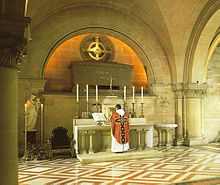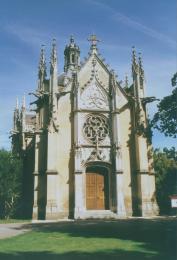Saint Michael's Abbey

Saint Michael's Abbey is a Benedictine Abbey in Farnborough , Hampshire , England.
history
The foundation stone for the abbey was laid in 1881 by the French ex-empress Eugénie de Montijo (1826–1920). It should be used as a mausoleum for her late husband Napoleon III. (1808–1873) and their son , who both found their final resting place in the Imperial Crypt . Together with Eugénie they lie in a granite sarcophagus.
The monastery was initially inhabited by Premonstratensians . In 1895, Eugénie replaced the Premonstratensians with French Benedictine monks from Solesmes . Fernand Cabrol , monk and scholar, became prior and later abbot (1903), at the same time Henri Leclercq and a small group of French monks joined the monastery. Leclercq and Cabrol worked together for many years on the Dictionnaire d'archéologie chrétienne et de liturgie . Once praised for their scholarly writings and musical tradition of Gregorian chant, the community shrank around 1947 and was reinforced by a small group of English monks from Prinknash Abbey . The last French monk, Dom Zerr, died in 1956. In 2006 the community elected the first English abbot of Farnborough, Right Reverend Dom Cuthbert Brogan.
Public tours of the abbey take place every Saturday at 3 p.m. The tour includes the church and the crypt.
The abbey church
The abbey church was built in neo-Gothic style by the well-known French architect Gabriel-Hippolyte Destailleur .
It houses a famous two-manual organ from 1905, which was created by the well-known organ builder Aristide Cavaillé-Coll & Company . However, the origins of the instrument are unclear. Although it was only installed after Cavaillé-Coll's death, it bears his name instead of that of his son-in-law Charles Mutin . The interior work is of such a quality that it is a clear testimony to the high standard of craftsmanship this company has at its prime.
The abbey church has housed a small organ from the Mutin Cavaillé-Coll company (successor to Aristides) since 1899 . It was expanded in 2000 by the Klais / Bonn company . The instrument has 14 registers, divided into two manuals and pedal, as well as three transmissions. The actions are mechanical.
|
|
|
||||||||||||||||||||||||||||||||||||||||||||||||||||||||||||
-
Pairing :
- Normal coupling: II / I, I / P, II / P
- Sub-octave coupling: II / I
- Playing aids : Trémolo for the whole organ
Organ lectures are given on the first Sunday afternoon of each month.
The church also houses the hip bone of St. Alban of England , the most important relic of this saint in England.
National Catholic Library
The Catholic Central Library was established by the Catholic Truth Society after the First World War . It was looked after by Franciscans for many years . In 2007 she moved to St. Michael's Abbey for the time being pending a final decision about her future. In the same year it was renamed the Catholic National Library ; it is one of the outstanding collections of Catholic literature in England.
Web links
- The official website of St Michael's Abbey, Farnborough
- A website about the famous Cavaillé-Coll organ
- Photography workshops at Farnborough Abbey (with galleries)
Coordinates: 51 ° 17 ′ 49.8 " N , 0 ° 44 ′ 58.4" W.
